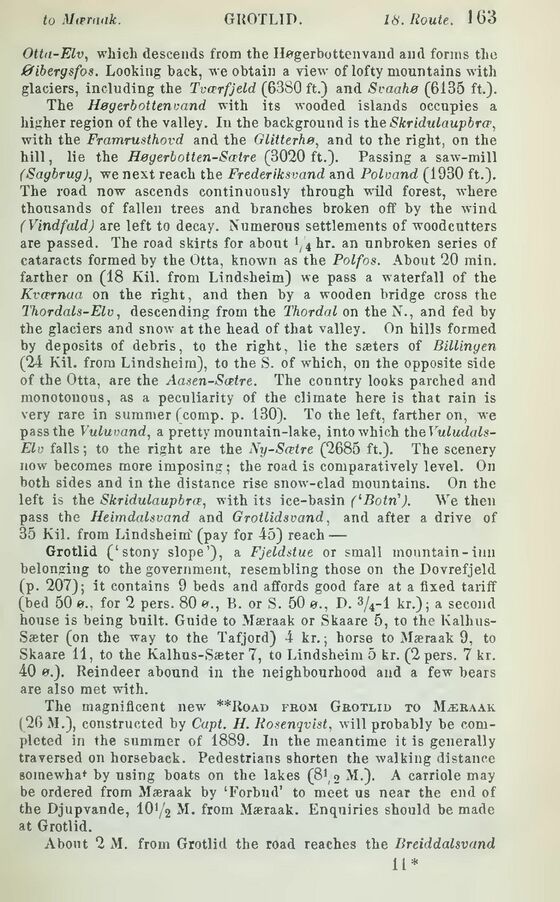
Full resolution (JPEG) - On this page / på denna sida - Norway - Pages ...

<< prev. page << föreg. sida << >> nästa sida >> next page >>
Below is the raw OCR text
from the above scanned image.
Do you see an error? Proofread the page now!
Här nedan syns maskintolkade texten från faksimilbilden ovan.
Ser du något fel? Korrekturläs sidan nu!
This page has never been proofread. / Denna sida har aldrig korrekturlästs.
Otta-Elv, which descends from the Høgerbottenvand and forms the
Øibergsfos. Looking back, we obtain a view of lofty mountains with
glaciers, including the Tvarfield (6380 ft.) and Svaahe (6135 ft.).
The Høgerbottenvand with its wooded islands occupies a
higher region of the valley. In the background is the Skridulaupbra,
with the Framrusthovd and the Glitterhø, and to the right, on the
hill, lie the Høgerbotten-Scetre (3020 ft.). Passing a saw-mill
(Sagbrug), we next reach the Frederiksvand and Polvand (1930 ft.).
The road now ascends continuously through wild forest, where
thousands of fallen trees and branches broken off by the wind
(Vindfald) are left to decay. Numerous settlements of woodcutters
are passed. The road skirts for about ^4 hr. an unbroken series of
cataracts formed by the Otta, known as the Polfos. About 20 min.
farther on (18 Kil. from Lindsheim) we pass a waterfall of the
Kvcernaa on the right, and then by a wooden bridge cross the
Thordals-Elv, descending from the Thordal on the N., and fed by
the glaciers and snow at the head of that valley. On hills formed
by deposits of debris, to the right, lie the sæters of Billingen
(24 Kil. from Lindsheim), to the S. of which, on the opposite side
of the Otta, are the Aasen-Sætre. The country looks parched and
monotonous, as a peculiarity of the climate here is that rain is
very rare in summer (comp. p. 130). To the left, farther on, we
pass the Vuluvand, a pretty mountain-lake, into which
theVuludals-Elv falls; to the right are the Ny-Satre (2685 ft.). The scenery
now becomes more imposing; the road is comparatively level. On
both sides and in the distance rise snow-clad mountains. On the
left is the Skridulaupbra, with its ice-basin Botn’). We then
pass the Heimdalsvand and Grotlidsvand, and after a drive of
35 Kil. from Lindsheim" (pay for 45) reach —
Grotlid (‘stony slope’), a Fjeldstue or small mountain-inn
belonging to the government, resembling those on the Dovrefjeld
(p. 207); it contains 9 beds and affords good fare at a fixed tariff
(bed 50 0., for 2 pers. 80 ø., B. or S. 50 ø., D. 3/4-l kr.); a second
house is being built. Guide to Mæraak or Skaare 5, to the
Kalhus-Sæter (on the way to the Tafjord) 4 kr.; horse to Mæraak 9, to
Skaare 11, to the Kalhus-Sæter 7, to Lindsheim 5 kr. (2 pers. 7 kr.
40 0.). Reindeer abound in the neighbourhood and a few bears
are also met with.
The magnificent new **Road from Grotlid to Mæraak
(26 M.), constructed by Capt. H. Rosenqvist, will probably be
completed in the summer of 1889. In the meantime it is generally
traversed on horseback. Pedestrians shorten the walking distance
soinewha* by using boats on the lakes (8(0 M.). A carriole may
be ordered from Mæraak by ‘Forbud’ to meet us near the end of
the Djupvande, lO1/^ M. from Mæraak. Enquiries should be made
at Grotlid.
About 2 M. from Grotlid the road reaches the Breiddalsvand
<< prev. page << föreg. sida << >> nästa sida >> next page >>